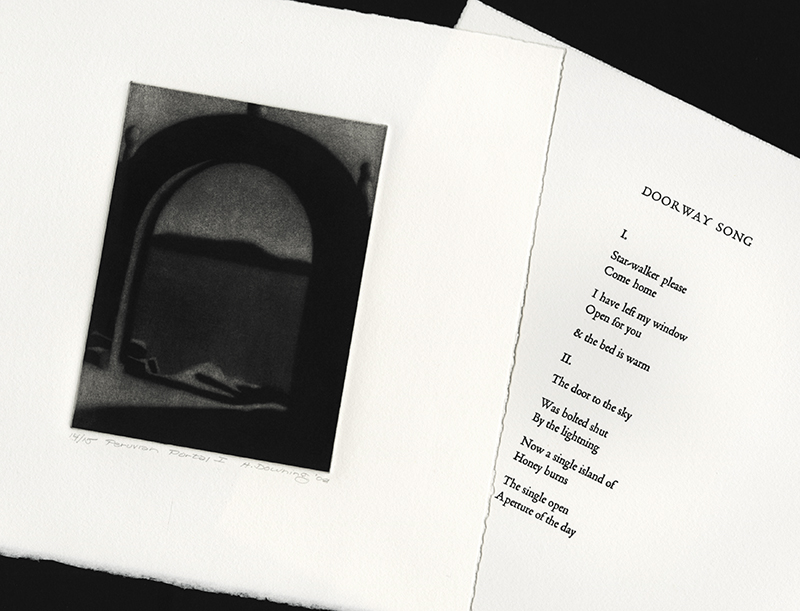Peruvian Portals, a loose-leaf collection of seven mezzotints accompanied with typeset poetry, is a collaboration between mezzotint printmaker Holly Downing and American poet David St John. The text was handset and printed by Eric Johnson of Iota Press, Sebastopol. Both mezzotints and poems are printed on Rives BFK wove paper. The unbound collection is housed in a linen clamshell box. The edition was quite limited, this being numbered 14/15. Each mezzotint is pencil signed by the artist and the colophon is signed by both Downing and St. John. The platemark for each mezzotint measures 4-3/8 x 5-7/8 inches and clamshell box measures 10-7/8 x 10-7/8 x 1-1/8 inches.
The following is a quote from the colophon: Peruvian Portals was created in homage to the people and culture of the Andes. In that spirit, David St. John’s opening poem, “Doorway Song,” has been printed in Kichwa, an Ecuadorian subcategory of Quechua, which was translated by Margot Cifuentes of Ecuador.
The theme of passageways has been one that Downing has revisited throughout her career, in particular in the two series Peruvian Portals and Passaggio. Downing observes that these portals “...lead a traveler from one viewpoint to another: from an interior to an exterior, or from one main arterial street to another through an alleyway.” Passageways often indicate change; in Downing’s softly rendered mezzotints, capturing the gradual contrast of light and shadow, she invites the viewer to wonder what is on the other side - what, if possible, will change when they’ve passed through the portal.
Mezzotint is a form of engraving, whose subtle qualities are achieved with tone rather than line. The artist spends many hours “rocking” a copper plate until the plate has thousands of tiny indents, each with a bit of raised burr that hold a tremendous amount of ink. A fully rocked plate prints a lush, velvety black, unparalleled in any other medium. To obtain an image, the artist scrapes the surface of the plate, variously lowering the levels of the burrs so they will hold less ink and thereby yield gradations of dark and light. Gradually an image emerges out of the darkness. The plate is inked by hand and printed on an etching press
Holly Downing, painter, printmaker and teacher, was born in San Francisco in 1948. She studied art at the University of California, Santa Cruz earning her B.A. in 1972. Her studies continued at the Royal College of Art, London and at Goddard College where she was in the graduate program in Europe. Between the years 1974 and 1980, Downing resided in England where she researched the mezzotint technique earning her M.F.A. from Goddard College in 1980.
Downing taught art for twenty-three years at the Santa Rosa Junior College and prior to that she taught briefly at the University of California Santa Cruz and San Francisco State University. Her paintings and mezzotints have been exhibited internationally. She is a recipient of fellowships and grants from the National Endowment for the Arts; the Greenshields Foundation, Canada; the Arts Council of Great Britain; the Graham Foundation, Chicago; and the San Francisco Phelan Foundation. Downing is an elected member of the Royal Society of Painter-Printmakers, London.
Downing’s work is represented in the collections of the Scottish National Gallery, Edinburgh; the Victoria and Albert Museum, London; the New York Public Library, New York; the Ashmolean Museum, Oxford; the Bibliothèque nationale de France, Paris; the Portland Art Museum, Oregon; the Fine Arts Museums of San Francisco; and the Library of Congress, Washington, D.C. Her work is also found in numerous university and college art collections internationally.
Holly Downing's mezzotints are included in a number of publications, including The Mezzotint, History and Technique by Carol Wax, 1990; Holly Downing, 25 Years of Mezzotints, a catalogue raisonné, 2001; and Printmakers' Secrets edited by Tony Dyson, 2009.



